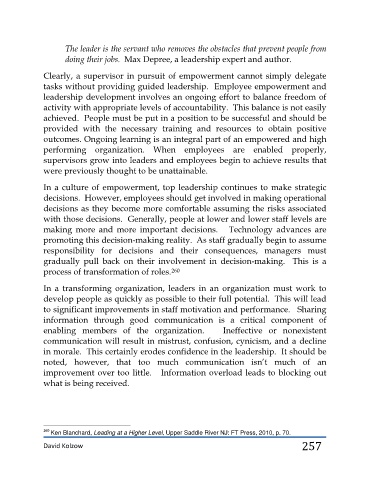Page 257 - 4- Leading_from_Within
P. 257
The leader is the servant who removes the obstacles that prevent people from
doing their jobs. Max Depree, a leadership expert and author.
Clearly, a supervisor in pursuit of empowerment cannot simply delegate
tasks without providing guided leadership. Employee empowerment and
leadership development involves an ongoing effort to balance freedom of
activity with appropriate levels of accountability. This balance is not easily
achieved. People must be put in a position to be successful and should be
provided with the necessary training and resources to obtain positive
outcomes. Ongoing learning is an integral part of an empowered and high
performing organization. When employees are enabled properly,
supervisors grow into leaders and employees begin to achieve results that
were previously thought to be unattainable.
In a culture of empowerment, top leadership continues to make strategic
decisions. However, employees should get involved in making operational
decisions as they become more comfortable assuming the risks associated
with those decisions. Generally, people at lower and lower staff levels are
making more and more important decisions. Technology advances are
promoting this decision-making reality. As staff gradually begin to assume
responsibility for decisions and their consequences, managers must
gradually pull back on their involvement in decision-making. This is a
process of transformation of roles.
260
In a transforming organization, leaders in an organization must work to
develop people as quickly as possible to their full potential. This will lead
to significant improvements in staff motivation and performance. Sharing
information through good communication is a critical component of
enabling members of the organization. Ineffective or nonexistent
communication will result in mistrust, confusion, cynicism, and a decline
in morale. This certainly erodes confidence in the leadership. It should be
noted, however, that too much communication isn’t much of an
improvement over too little. Information overload leads to blocking out
what is being received.
260
Ken Blanchard, Leading at a Higher Level, Upper Saddle River NJ: FT Press, 2010, p. 70.
David Kolzow 257

